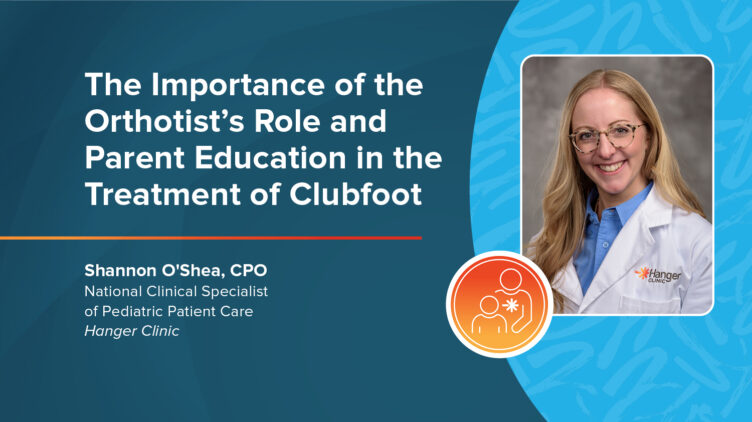The Importance of the Orthotist’s Role and Parent Education in the Treatment of Clubfoot

Clubfoot is a genetic condition that is estimated to affect approximately 1 of 750 children. Shannon O’Shea, CPO and National Pediatric Specialist, shares the role of an orthotist in treating clubfoot and the importance in providing education to empower parents to feel successful bracing at home.
What is clubfoot?
Clubfoot is a common type of genetic condition caused by a shortened Achilles tendon and affects the muscles and bones in the feet. Instead of being straight, one or both feet are twisted out of shape, pointing inward and downward.1
How is clubfoot treated?
To start, it’s important to know that clubfoot will not improve on its own. Treatment for clubfoot typically begins shortly after birth. Physicians or surgeons use a series of casts, gentle movements and stretches, and then the physician will prescribe lower limb bracing to continue to move the foot into a more corrected position. Your doctor may decide to use a casting procedure called the Ponseti Method that gently increases corrective positioning.
- Casting. Children with clubfoot are typically seen by an orthopedic surgeon for casting. The first cast is put on one or two weeks after your baby is born. Then, your baby returns to the surgeon about once a week for gentle moving and stretching of the foot and placement of a new cast. Each new cast continues to turn the foot more in the correct direction. Most babies will wear a series of 5 to 7 casts over a few weeks or months.2
- Bracing. Once the series of casts are complete, the orthopedic surgeon may refer your family to a certified orthotist at Hanger Clinic to fit your baby with a brace, also called an orthosis. The brace is a bar with special shoes or boots at each end. It keeps the foot from twisting back to where it was before the casting. Feet grow a lot and very quickly in the first years of life. Without the brace to keep a corrected clubfoot in the proper place, rapid growth would allow the foot to move back into the clubfoot position.2
When are clubfoot patients seen by an orthotist?
There will be a healthcare team caring for your child, possibly including an orthopedic surgeon, physical therapist, and orthotist. Oftentimes, this pathway starts before your child is born, as clubfoot is typically identified in a routine ultrasound. Shortly after birth, an orthopedic surgeon that specializes in clubfoot will begin discussing the treatment plan. Your orthopedic surgeon will complete a series of casting. Once the casting series is complete, the orthopedic surgeon send a prescription to the orthotist for bracing. This is when your family’s relationship with your orthotist will begin.
You will likely be seeing us for a long period of time as your clubfoot cutie grows. I always start my initial conversation telling my clubfoot families we are going to be friends, and we are going to see each other a lot. As a certified orthotist, we have a holistic understanding of clubfoot treatment and have been trained specifically to fit the braces. As mentioned prior, your child with have a healthcare team and may also see a physical therapist for stretching.
How long will my child wear a brace?
Multiple factors can impact how long your child will need to wear the brace, including the severity of their clubfoot, if one or both feet are being treated, and even their own growth rate. In the beginning, you can expect that your child will wear the brace for 23 hours a day. The most important thing parents can do to ensure the best outcomes for their child is to follow the treatment plan set by their orthotist. The brace can only be successful if it is being worn by the child as prescribed by the physician. We are working as a team to do everything possible to maintain the correction made during casting and prevent further interventions. Typically bracing treatment will last until the child turns 4-5 years old.
As children progress, parents see their children running, jumping, and playing with ease. They may start to think their child does not need the brace anymore, but it’s important to finish the full course of treatment and wearing time in the brace for the best long-term results. Remember, it’s a marathon, not a sprint.
From your perspective as an orthotist working with these club foot families, what do you think is the biggest challenge parents face when it comes to bracing?
I believe that wearing the brace for the length of time prescribed and consistently donning (putting on) the brace correctly are the biggest challenges.
Most often, your child is just an infant and their foot is incredibly small. It can be stressful for parents to put on the brace. We start by practicing at your appointment. At that initial appointment, I prefer to start by having you put the brace on your child’s unaffected foot if possible. It gives me an opportunity to talk you through everything, and your baby will be more comfortable. Then we move to your child’s affected side, or the foot that was casted. Typically, your child may cry and fuss more with this foot. That is because this foot may have just come out of a cast, and the skin is hypersensitive to touch. Additionally, we are stretching the foot on this side, which may feel less comfortable for your child.
Our goal is to get the brace on correctly and get it tight so that the deformity is held and we are not allowing it to potentially regress. Repetition is key at the beginning. The more you practice, the easier it becomes and the more confident you get, then it just becomes part of your routine. Adjusting to this process can be stressful on parents, but it is all worth it in the end to help keep the foot correction.
Shannon O’Shea: The Orthotist’s Role in Clubfoot Treatment
Clubfoot mom and Hanger Clinic orthotist Shannon O’Shea, CPO, discuss the importance of the orthotist and parent’s roles in caring for your clubfoot cutie.

When should parents reach out to their orthotist?
The simple answer is whenever you have questions. As your orthotist, we are a part of your healthcare team and here to help answer any questions to ultimately provide the best care for your child. You can reach out or schedule an appointment for reassurance you are putting on the device correctly or to confirm the brace is functioning properly. You may notice redness from the brace. It is important to reach out to your orthotist before blisters develop to possibly make adjustments. Remember, we can only help if we are aware of any situations. If you are not sure if your question is best addressed by your orthotist or another member of your care team, just reach out to us and ask.
Any last thoughts for parents?
Clubfoot is now typically identified when your child is in the womb. Once your newborn is in your arms, it can be a happy and overwhelming time of life. Having a child is a huge change in everyone’s routine. You are learning about yourself and your child during that time, and then you add into the mix learning how to use a brace. This can feel overwhelming on top of feedings, diapers, and everything else in life. You may leave the office thinking you understood everything shared, and then get home and feel self-doubt. Every parent working with their clubfoot cutie should know you are doing a great job, and if you need more support your orthotist is here to help.
Request a Free Evaluation
If you or someone you love is looking for personalized orthotic care, get in touch with a board-certified orthotist at a Hanger Clinic near you.
Latest Updates
Subscribe to stay up-to-date on our latest posts.


